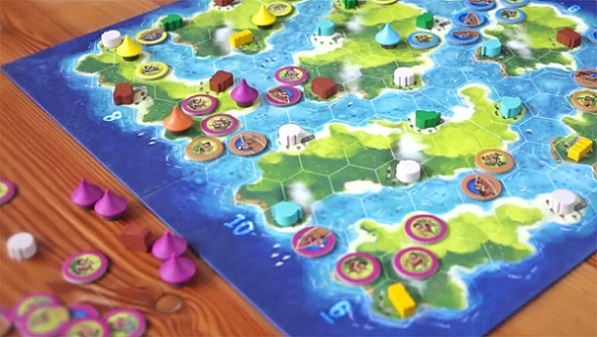Control the Blue Lagoon by Exploring, Settling, and Collecting Resources

Explore the lagoon, gather resources, build villages, and lay claim to the islands!
Blue Lagoon is an area control game played in two phases, in which the villages you place in the first half of the game dictate your options in the second half.
Gameplay
The game board features eight islands. Each island is made up of a series of hexagonal spaces and are connected to each other by water, which is also comprised of hexagonal spaces. On the islands there are also resource spaces — there are four types of resources plus statuettes. Blue Lagoon is comprised of two phases. At the beginning of each phase, all the resources and statues are randomly placed on the board so that there is one item on each of the resource spaces.
Each player has five village tokens and multiple settler tokens. Settler tokens show a boat on one side and land on the other, while villages can only be placed on land. On your turn you may place a villager or a settler. There can only be one piece per space. If you place either on a resource location, you collect the resource. Any villages on a resource location will be returned to the box at the end of the first phase of the game, along with any unused villages. Both phases of the game end either when all players run out of pieces to add to the board or once all resources are collected.
During the first phase of the game, players can place boat tokens on any unoccupied space in the water. However in order to place a settler on the land, it must be adjacent to a piece you have already placed on the board.
Once the first phase ends, points are calculated, then all settler pieces are removed from the board and returned to their players (any villages not placed on a resource space stay on the board). Points are scored in six different ways. Players earn ten or twenty points if they have pieces on seven or eight of the islands. For your longest line of connected pieces you earn five points for each island the chain links. You earn six to ten points (depending on the island) for having the most pieces on an island. You earn five, ten, or twenty points for having two to four copies of a resource. You earn ten points for having at least one of each resource. Finally, you earn four points for each statue.
The second phase of the game is exactly the same as the first, only now when adding a new piece to the board it must be adjacent to another one of your pieces regardless of whether it is land or water. This means instead of placing boats in the ocean to start new chains, you start adding pieces from where your villages are. The second round scores the same as the first, and the player with the most points at the end of the game wins.

Review
The core mechanics of Blue Lagoon are simple to learn while still providing strategic decisions and many options every turn. The two phases of the game balance each other nicely. During the first you have a lot more freedom about placing your pieces, as you can start new chains on any water space. This lets you spread out faster, while in the second half of the game you are much more bound by your villages, making it harder to reach various areas of the map.
This need to think ahead when placing your villages adds a great layer to the gameplay. You want to consider where the resources are, where other players are placing their villages, how much time you have left to place the villages, and even where your other villages already are.
The scoring itself means that you are constantly trying to balance which goals to work towards and what to make your priority. Do you want to push ahead and land on all eight islands? Or do you want to focus on building a long chain of pieces? Players can also block each other, particularly during the second half of the game, making these goals even harder to achieve.
Turns in the game are quite fast, since all you have to do is place a piece — and chances are you’ve figured out where you want to go while the other players take their turns. However, the two breaks in the game to calculate scores do slow things down and can get a little complicated. It would also be nice if the game came with player aid cards to help players remember the various ways to score.
If you like abstract games, particularly those with a limited number of rules, you should check out Blue Lagoon. It has lots of replay value and intriguing choices.
Pros: The two phases complement each other well, lots of strategy to consider, easy to learn
Cons: Scoring takes a while, no player aid cards
Disclosure: we received a complimentary review copy of this game.







